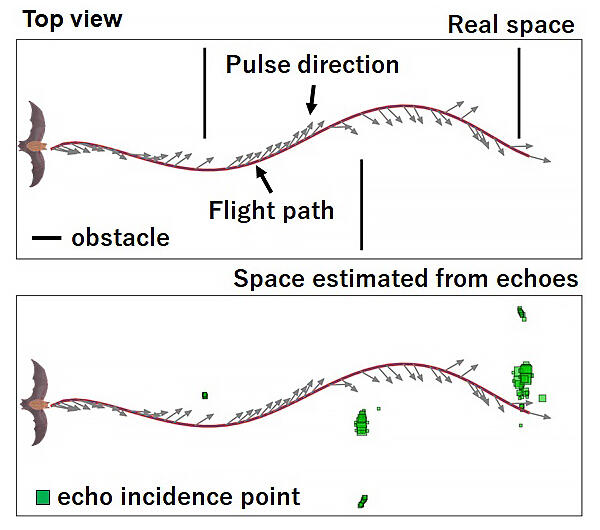Bats fly around by registering space via ultrasonic waves, but, in fact, it turns out that there is a difference between space that bats perceive and the actual space. Doshisha University Faculty of Life and Medical Sciences graduate student Yu Teshima, Professor Shizuko Hiryu, and Faculty of Science and Engineering Professor Takao Tsuchiya, in collaboration with Hiroshima University, discovered that the obstacles in space that bats register via sound echoes is different from the actual space, and that bats efficiently register important locations for flight. This research was published in BMC Biology.

Provided by Doshisha University
It is well known that bats fly by understanding their surrounding environment by listening to and analyzing the echoes from ultrasonic sounds (pulses) that the bats themselves emit. The ability of bats to register spaces via sounds is highly developed so that they can continuously prey on small insects at high speeds without hitting any obstacles in the dark. On the other hand, because bats sometimes hit large, smooth walls, and other obstacles, it was believed that the spaces registered by bats via echolocation are different from spaces that are visually recognized.
In other words, it is possible that bats, based on the information they receive from echoes, are constructing their own recognition space that is different from the actual space that we see visually. However, in order to estimate the spaces that bats register, it is necessary to acquire all of the echoes from the surroundings that reach a bat's left and right ears, but due to technical limitations it had been difficult to measure the echoes.
To solve this problem, the research group made it possible to reconstruct echoes by combining behavioral measurements and acoustic simulations in real spaces with obstacles. Then, by calculating the location where a pulse emitted by a bat is reflected (an echo source), the research group visualized the space (echo space) composed of all the echo sources and examined the obstacle space that bats can grasp from the echoes.
A space with three acrylic plates was prepared as an obstacle, and, when the bats were made to fly through it, they flew in an S-shaped route so as to avoid the plates. When the echo space was visualized, it became clear that it was primarily composed of the edge portions of the plate-shaped obstacle, which are important places for avoiding the obstacle. Additionally, the echo sources were more concentrated at the edges both when the bat flew in the obstacle space for the first time and in the 12th flight when the space had been sufficiently learned, and the research group found that information near obstacle edges, which are important for avoidance behaviors, was efficiently acquired by emitting a small number of pulses.
Furthermore, the research group analyzed changes in the turning angular velocity of flight, the direction of pulse emission and the direction of echo arrival when the bats flew through a space with obstacles. As a result, the research group knew that the pulse emission direction changed prior to turning at an angular velocity, and they clarified, for the first time, that echo arrival direction changed before the bats' turned at an angular velocity. In other words, the direction of an echo source may affect the control of a bat's flight direction (turning at an angular velocity).
Through this method, it is possible to reconstruct the echoes that reach bats during flight. As a result, both the "echo," which is the input information for the bat, and the "flying/pulse," which are the output actions from the bat, can be acquired, and, from the relationship between input and output information when thinking of bats as a system, it can be expected that bat's behavior rules can be clarified. By using an extremely simple model of transmitters (mouth or nose) and receivers (both ears) to model the sonar mechanism that bats use to understand space, the research group expects that new sensing methods derived from living organisms will be established and that engineering applications will follow.
This article has been translated by JST with permission from The Science News Ltd.(https://sci-news.co.jp/). Unauthorized reproduction of the article and photographs is prohibited.




